outcomes of casting nets of bifurcating dynamic tines and trying to hold onto something....on some scale....in some location....for some duration of time (ultimately to be let go...the boundary of holding)
Wednesday, October 27, 2010
Use as Directed film (at onedotzeroadventures in motion festival) as story body system
If you happen to go to the onedotzero adventures in motion festival at the British Film Institute, from 11-14 November, you'll be able to attend a screening of Use as Directed by Ansted Moss, in Wow+Flutter 10:
Use as Directed is a story system about systems of convergence and conspiracy, where parts intersect and interact as a single body to accomplish a shared goal. Once connection between parts is established, the body system benefits from a combining of forces. The body system is a more powerful complex structure than any single part comprising the body system.
In the animation technique of this short film, some visual distinctness of each component of the composite structure remains apparent, loss of distinction tending to occur where boundaries touch and opportunity for merger is asserted to varying degrees on various scales. The merged form is the offspring of interaction (1+1=3 again, as Rima pointed out earlier in the semester).
Participation in this story body system does not render the components unable to be part of other systems, but some form of memory of having been attached to this Use as Directed body system will likely travel with the components into other systems of (temporary) connection.
Use as Directed explores formation of a story body system, and formation of purpose for body assemblage. In establishing configurability of the body, Use as Directed suggests that other configurations are possible; the built body could be unbuilt then rebuilt differently, that story related to stories of other configurations, but not exact duplicates, of course; any given configuration perhaps seemingly more endearing for the unlikelihood of exact duplication. Then too, this configurability suggests a generalized compatibility of parts, even that anything be considered a part, and certainly in the manipulation strategies of a maker, that which is prevented from being combined according to rules and obstructions of three-dimensional reality, can be combined in the various spaces and media of aesthetic and imaginative expression. Designation as part brings with that designation, an idea that part should connect with or be a component of something, should become a part of something, leaving bits and parts of itself behind during the tenure of the temporary partnership, and acquiring something from other parts of a body system in which a part has temporary membership.
Explore more of Ansted's visual theory at kna'Knox.com
Use as Directed from Ansted Moss on Vimeo.
Use as Directed is a story system about systems of convergence and conspiracy, where parts intersect and interact as a single body to accomplish a shared goal. Once connection between parts is established, the body system benefits from a combining of forces. The body system is a more powerful complex structure than any single part comprising the body system.
In the animation technique of this short film, some visual distinctness of each component of the composite structure remains apparent, loss of distinction tending to occur where boundaries touch and opportunity for merger is asserted to varying degrees on various scales. The merged form is the offspring of interaction (1+1=3 again, as Rima pointed out earlier in the semester).
Participation in this story body system does not render the components unable to be part of other systems, but some form of memory of having been attached to this Use as Directed body system will likely travel with the components into other systems of (temporary) connection.
Use as Directed explores formation of a story body system, and formation of purpose for body assemblage. In establishing configurability of the body, Use as Directed suggests that other configurations are possible; the built body could be unbuilt then rebuilt differently, that story related to stories of other configurations, but not exact duplicates, of course; any given configuration perhaps seemingly more endearing for the unlikelihood of exact duplication. Then too, this configurability suggests a generalized compatibility of parts, even that anything be considered a part, and certainly in the manipulation strategies of a maker, that which is prevented from being combined according to rules and obstructions of three-dimensional reality, can be combined in the various spaces and media of aesthetic and imaginative expression. Designation as part brings with that designation, an idea that part should connect with or be a component of something, should become a part of something, leaving bits and parts of itself behind during the tenure of the temporary partnership, and acquiring something from other parts of a body system in which a part has temporary membership.
Explore more of Ansted's visual theory at kna'Knox.com
Monday, October 25, 2010
Animation!
I'm now working with stop motion to animate my Indian character exploring a new city. I've been drawing the figure in chalk on brick walls, and planning to start working with pens on a mirror....
http://www-personal.umich.edu/~nicolab/_MG_0026.JPG
http://www-personal.umich.edu/~nicolab/_MG_0026.JPG
http://www-personal.umich.edu/~nicolab/_MG_0026.JPG
http://www-personal.umich.edu/~nicolab/_MG_0026.JPG
Friday, October 22, 2010
More mistakes (the good kinds)


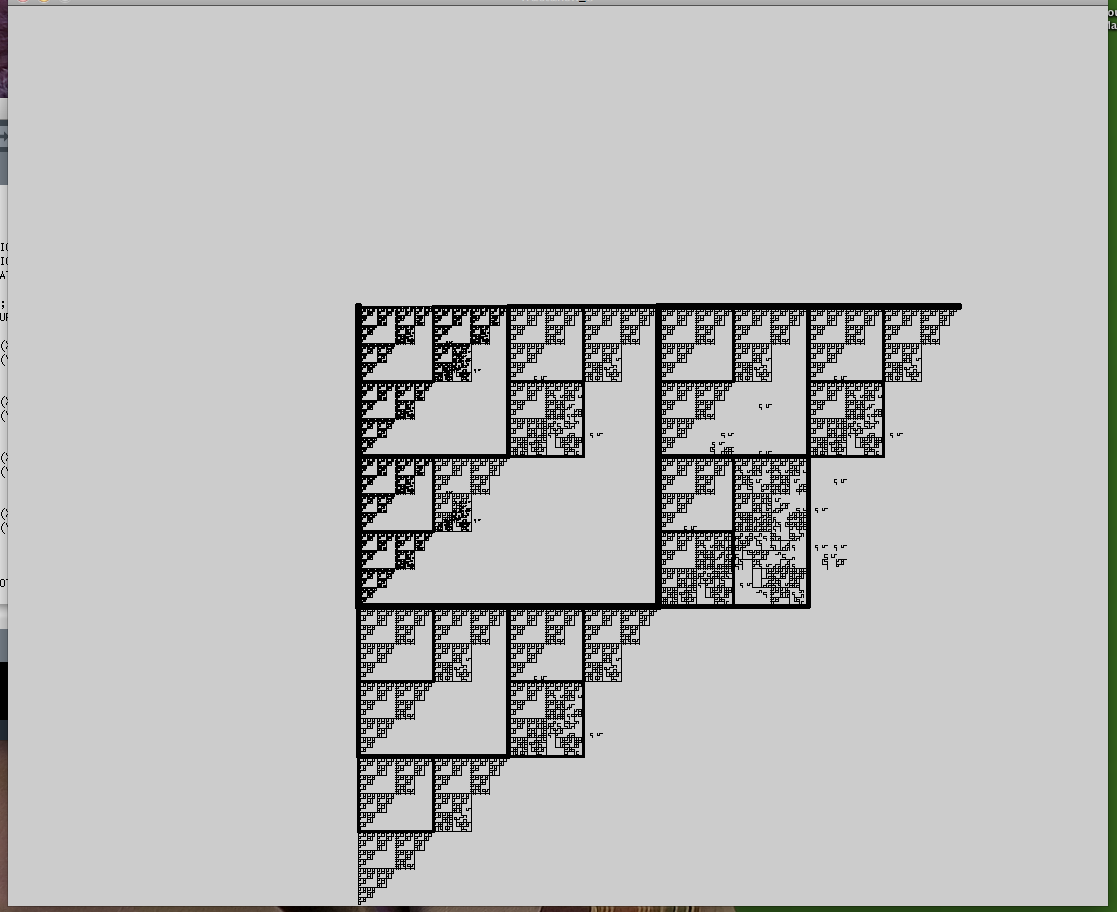
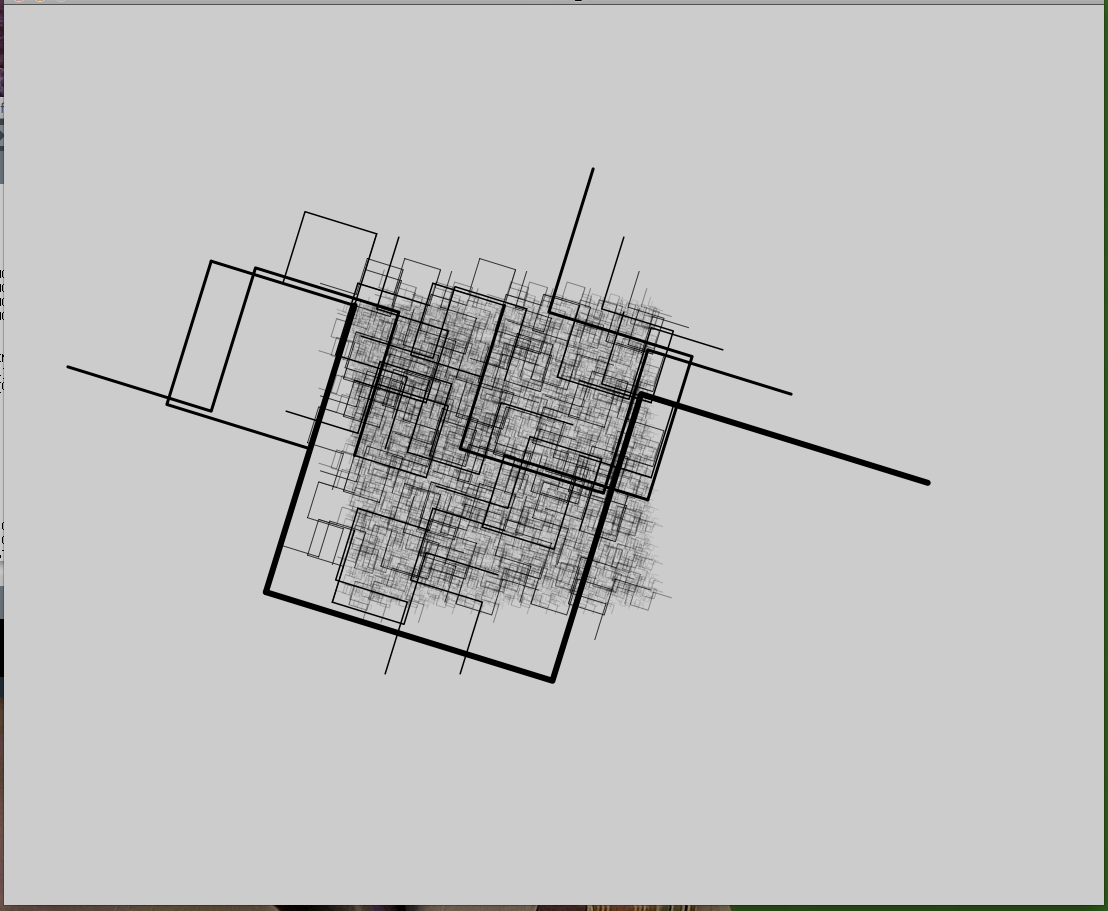

Here are more mistakes from a little while ago. There are still "fuzzy" parts and it isn't iterating quite right, but the fuzz may be due to how Processing deals with rounding numbers. Either way, the parts that break the intended rules actually seem to be following very specific rules and are fractal.
All the past stuff was just a part of the bigger picture
I haven't posted for a bit due to a large influx of projects, as well as my ideas changing rather rapidly to reveal some much more interesting and larger scale concepts that my previous ideas were but a small piece of. The lack of visuals is due to tue fact that none of these ideas are terribly visual, or at least I don't have the tools (yet) to show the concepts visually; pictures would only serve as distractions and eye candy.
Thee first step now is to either find some one (which is turning out to be the less possible route) or learning a language like R to code myself something to do fourier transforms on whole pieces of music as if they are one cycle of a waveform. The component harmonics will then have to be visualized in an appropriate way so different orders of magnitude can be seen to try to figure out if rhythms, structure, envelope, key and notation, and timbre qualities become apparent from the component audio and sub-audio frequencies. Can music (not musical notations which IS NOT music) be analyzed and visualized purely using the dimension of component harmonica of the whole.
How to pieces differ?
How do genres and movements differ?
What does it sound like if you re-synthesize the sound missing a certain order of magnitude of component frequencies?
What does taking the rhythm harmonics of one piece, the timbre of another, etc and synthesizing them together sound like?
Are their patterns and rules that can be used to generate wholly new music and sounds from the component harmonic level?
What if fractal patterns are applied?
Can the human aspect be seen? Reproduced?
Can the organic be faked?
Are their other techniques besides fourier transforms that can reveal new dimensions, more depth, new synthesis techniques?
The tools are relatively simple and common, the data sets are huge. There is a tiny chance humanity and the organic can be reconstructed, decomposed, and reinvented. This all will probably take years or even a lifetime to pursue. Fun, no?
Thee first step now is to either find some one (which is turning out to be the less possible route) or learning a language like R to code myself something to do fourier transforms on whole pieces of music as if they are one cycle of a waveform. The component harmonics will then have to be visualized in an appropriate way so different orders of magnitude can be seen to try to figure out if rhythms, structure, envelope, key and notation, and timbre qualities become apparent from the component audio and sub-audio frequencies. Can music (not musical notations which IS NOT music) be analyzed and visualized purely using the dimension of component harmonica of the whole.
How to pieces differ?
How do genres and movements differ?
What does it sound like if you re-synthesize the sound missing a certain order of magnitude of component frequencies?
What does taking the rhythm harmonics of one piece, the timbre of another, etc and synthesizing them together sound like?
Are their patterns and rules that can be used to generate wholly new music and sounds from the component harmonic level?
What if fractal patterns are applied?
Can the human aspect be seen? Reproduced?
Can the organic be faked?
Are their other techniques besides fourier transforms that can reveal new dimensions, more depth, new synthesis techniques?
The tools are relatively simple and common, the data sets are huge. There is a tiny chance humanity and the organic can be reconstructed, decomposed, and reinvented. This all will probably take years or even a lifetime to pursue. Fun, no?
Wednesday, October 20, 2010
Motion!
My Little Indian Character being told to Stop. Walk. Answer. Close. Belt-Up. Eat-Up. Consume.
FreeVideoCoding.com
FreeVideoCoding.com
Wednesday, October 13, 2010
It's been a while since I've posted, but I needed some time to gather my thoughts and try to come up with a system of both limitation and extraction. I like the idea of creating through systematic processes, taking something that already exists in a certain form and generating new meanings and forms from its content. This is how the universe is constructed out of atoms (the formation of molecules and elements leads to the solids, liquids, and gases that define our tangible world).
This is a concept map of my understanding of reality. As humans we take in sensory input that generates memory, is stored in our brain, gives context and meaning, is translated into language. Everything is about translation and regeneration.

This is a concept map of how stories are told. An event occurs, sensory input is stored in the brain, it is recalled, translated into words, given meaning, symbols, context, etc.

I have never been a big reader of newspapers or watcher of the news. It is a limited, controlled stream of information that is chosen by the network or company. Those networks and companies are funded largely by advertising. Therefore, large businesses control our news sources, only letting the information they deem worthy to be released to the public. So much information slips through the tines of the news-fork system. I wanted to take newspapers, daily accumulations of stories, and limit them even farther in order to generate new stories. Instead of taking the news at face value or even reading between the lines, I am interested in returning to the actual construction of language, to semiotics.
Working solely with University of Michigan print publications, I began by choosing words myself, making blackout poetry. This was a hard endeavor to undertake because the subject matter of the newspaper did not lend itself to much of interest. It was tiring to compose in this way and not systematic enough for my taste. Sometimes delightful things would happen, but it didn't delve into sentence construction and the English language like I wanted it to. It was just a way of making pretty a word combination:

today it becomes more through simplifying and allowing open doors in life,"
Then I found out about John Cage's system which he calls "CIRCUS ON ______". He would take existing writing and find words that began with certain letters, extracting an acrostic poem. Those words could then be used to create something new. I did this with an entire copy of The Statement from September 29, 2010. The main article was on stem cell research so that was the acrostic I pulled out. I have quoted the resultant words, grouped by article, below:
"state the eating million coconuts? eat last looking really earth speck ever acceptable rival
stories the Elmo Mark CEO effort leader
Society the event Mexican Chilean echo listserve
save to eat meet campus events like life
SEARCH THE Eva molecular cure Europe least lives regenerate eats seconds. Even athletes reason claims human stem treat Emory more corridor established, last last right. embryos. state embryos also researchers California housed stem that executive Michigan, calls eventually lead lines regulation existing stem embryonic According received couples. human stem that embryos. Morrison called embryonic Last law researchers each start embryo analyzed recommendations Congress, hanging said. that economic Michigan Cell Economics like left research even stem embryonic amendments Rivet, countries hours stem the Economic Michigan, Carl evaluated Lastly, looked research embryonic strides even and researchers come hope
Sixty those —entirely midnight crowd exhibitionists. lewd lists Review end Street. excessive a responded could he supervising the encourage mean campus, else list, lists Review’s editor survey each and rankings can he say.” the emphasis majority categorizes everyone labeled list reputation each scene especially and randomly campus here school. the evident meets Cervi, events like like responsibly everybody sometimes enter as
STATEMENT told episode my college even legal lawyers reasons), entourage surround exploitation a realized create how show to every minutes conversation emotional like legally reaction enough. sound episode air realized chapter hope"
While I found John Cage's method interesting, I want to make sentences that contain the correct parts of speech. I want to make something where I can interchange words, and therefore meanings, to take a closer look at semiotics. In what feels like the opposite of MadLibs, I want to come up with systems of extraction for different grammatical parts of speech in the English language:
nouns (including pronouns)
verbs
adjectives
adverbs
prepositions
conjunctions
interjections
I have come up with several different systems I am going to try on the same newspaper:
1. MASH: When I was a kid we would play a game called MASH (Mansion, Apartment, Shack, House) which was meant to predict the outcome of your future. You would make categories like job, salary, husband's name, pet, wedding dress color, etc. and then use a number (determined "randomly") to systematically count through all of the listings. Each time you hit the magic number, that option was crossed out. If there's only one thing left in each category, it's left as the final "answer." I want to try this system using the date of publication as the number (specifically the number denoting the day of the month).
2. Alphabetical: Choosing only parts of speech that start with the same letter to create alliterations.
3. Take the first noun from the first article, the second verb from the second article, the third adjective from the third article, etc. and create one sentence that sums up the whole publication.
I am sure that I will come up with more systems to test out and I will add them to my list. Once I find one that I like, I would like to employ it on a whole series of papers. The next step will be to take my chosen words and create something new out of them.
EDIT:
I found some other interesting work that relates to what I'm doing. First, here's an interesting video called Everything's a Remix:
It mentioned a book called The Soft Machine by William S. Burroughs. He takes other writing, cuts & folds it, and creates a new work. Pretty cool if you ask me!

This is a concept map of how stories are told. An event occurs, sensory input is stored in the brain, it is recalled, translated into words, given meaning, symbols, context, etc.

I have never been a big reader of newspapers or watcher of the news. It is a limited, controlled stream of information that is chosen by the network or company. Those networks and companies are funded largely by advertising. Therefore, large businesses control our news sources, only letting the information they deem worthy to be released to the public. So much information slips through the tines of the news-fork system. I wanted to take newspapers, daily accumulations of stories, and limit them even farther in order to generate new stories. Instead of taking the news at face value or even reading between the lines, I am interested in returning to the actual construction of language, to semiotics.
Working solely with University of Michigan print publications, I began by choosing words myself, making blackout poetry. This was a hard endeavor to undertake because the subject matter of the newspaper did not lend itself to much of interest. It was tiring to compose in this way and not systematic enough for my taste. Sometimes delightful things would happen, but it didn't delve into sentence construction and the English language like I wanted it to. It was just a way of making pretty a word combination:

Then I found out about John Cage's system which he calls "CIRCUS ON ______". He would take existing writing and find words that began with certain letters, extracting an acrostic poem. Those words could then be used to create something new. I did this with an entire copy of The Statement from September 29, 2010. The main article was on stem cell research so that was the acrostic I pulled out. I have quoted the resultant words, grouped by article, below:
stories the Elmo Mark CEO effort leader
Society the event Mexican Chilean echo listserve
save to eat meet campus events like life
SEARCH THE Eva molecular cure Europe least lives regenerate eats seconds. Even athletes reason claims human stem treat Emory more corridor established, last last right. embryos. state embryos also researchers California housed stem that executive Michigan, calls eventually lead lines regulation existing stem embryonic According received couples. human stem that embryos. Morrison called embryonic Last law researchers each start embryo analyzed recommendations Congress, hanging said. that economic Michigan Cell Economics like left research even stem embryonic amendments Rivet, countries hours stem the Economic Michigan, Carl evaluated Lastly, looked research embryonic strides even and researchers come hope
Sixty those —entirely midnight crowd exhibitionists. lewd lists Review end Street. excessive a responded could he supervising the encourage mean campus, else list, lists Review’s editor survey each and rankings can he say.” the emphasis majority categorizes everyone labeled list reputation each scene especially and randomly campus here school. the evident meets Cervi, events like like responsibly everybody sometimes enter as
STATEMENT told episode my college even legal lawyers reasons), entourage surround exploitation a realized create how show to every minutes conversation emotional like legally reaction enough. sound episode air realized chapter hope"
While I found John Cage's method interesting, I want to make sentences that contain the correct parts of speech. I want to make something where I can interchange words, and therefore meanings, to take a closer look at semiotics. In what feels like the opposite of MadLibs, I want to come up with systems of extraction for different grammatical parts of speech in the English language:
verbs
adjectives
adverbs
prepositions
conjunctions
interjections
I have come up with several different systems I am going to try on the same newspaper:
1. MASH: When I was a kid we would play a game called MASH (Mansion, Apartment, Shack, House) which was meant to predict the outcome of your future. You would make categories like job, salary, husband's name, pet, wedding dress color, etc. and then use a number (determined "randomly") to systematically count through all of the listings. Each time you hit the magic number, that option was crossed out. If there's only one thing left in each category, it's left as the final "answer." I want to try this system using the date of publication as the number (specifically the number denoting the day of the month).
2. Alphabetical: Choosing only parts of speech that start with the same letter to create alliterations.
3. Take the first noun from the first article, the second verb from the second article, the third adjective from the third article, etc. and create one sentence that sums up the whole publication.
I am sure that I will come up with more systems to test out and I will add them to my list. Once I find one that I like, I would like to employ it on a whole series of papers. The next step will be to take my chosen words and create something new out of them.
EDIT:
I found some other interesting work that relates to what I'm doing. First, here's an interesting video called Everything's a Remix:
Everything is a Remix from Kirby Ferguson on Vimeo.
It mentioned a book called The Soft Machine by William S. Burroughs. He takes other writing, cuts & folds it, and creates a new work. Pretty cool if you ask me!
Tuesday, October 12, 2010
Constructing the Story Body (where tines converge)
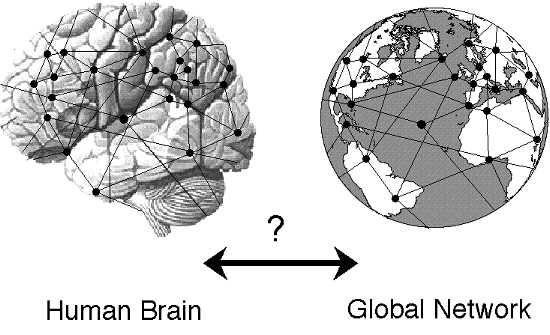
 In this approach, story system (system in part because multiple angles, multiple configurations, multiple modes of expression, etc. will be considered, and system because different parts are involved, a telling that is not a single narrative element, an unfolding that could be interactive, might not be expected to end, an unfolding that could be generative, etc.); in this approach, the story system will be considered as an organism, something that reacts to and responds to its environment, something that can grow, change, something that came into existence somehow, with or without intelligent design; an entity that is part of a community of possibly similar and possibly dissimilar entities/iterations (that community can be as local as the multicellular organism's own body and as distant as the superorganisms that form from interactions of multiple organisms, collective dependence), an entity made of different parts of various function that together form and/or behave like a single entity, such as the human body (a cooperative society of human cells and microbes). (human brain and global network image from principia cybernetica's article: the social superorganism and its global brain, generative manifesto image from generative.net)
In this approach, story system (system in part because multiple angles, multiple configurations, multiple modes of expression, etc. will be considered, and system because different parts are involved, a telling that is not a single narrative element, an unfolding that could be interactive, might not be expected to end, an unfolding that could be generative, etc.); in this approach, the story system will be considered as an organism, something that reacts to and responds to its environment, something that can grow, change, something that came into existence somehow, with or without intelligent design; an entity that is part of a community of possibly similar and possibly dissimilar entities/iterations (that community can be as local as the multicellular organism's own body and as distant as the superorganisms that form from interactions of multiple organisms, collective dependence), an entity made of different parts of various function that together form and/or behave like a single entity, such as the human body (a cooperative society of human cells and microbes). (human brain and global network image from principia cybernetica's article: the social superorganism and its global brain, generative manifesto image from generative.net) While the story body can be or seem relatively static, can be a moment or moment-sequence isolated for examination, focus, zooming in or zooming out for a time-stopped, frame-by-frame opportunity to study details, etc.), in this Limited Fork Theory approach to constructing a story body, the static study will have as part of its purpose the seeking of insight into the story system's dynamic forms, movement of idea, evolution of idea, etc; the purpose of discovery. A single aspect of the story system (just one tine) can be the focus of the story body you construct, with some nod to the aspect's role or participation in or relationship to a larger (or smaller) system. What you focus on in your story system can be the container of subsystems of the story body, and your focus in your story system can be contained by larger systems or subsystems of something even larger.
While the story body can be or seem relatively static, can be a moment or moment-sequence isolated for examination, focus, zooming in or zooming out for a time-stopped, frame-by-frame opportunity to study details, etc.), in this Limited Fork Theory approach to constructing a story body, the static study will have as part of its purpose the seeking of insight into the story system's dynamic forms, movement of idea, evolution of idea, etc; the purpose of discovery. A single aspect of the story system (just one tine) can be the focus of the story body you construct, with some nod to the aspect's role or participation in or relationship to a larger (or smaller) system. What you focus on in your story system can be the container of subsystems of the story body, and your focus in your story system can be contained by larger systems or subsystems of something even larger. So we'll be entering the story body (which is a system) somewhere, a story body that, on some scale, is in progress; we enter something ongoing, establishing a tine that despite how innovative or new it might seem is nevertheless connected to (in some way[s]), is rooted in the already-established, the in-progress [hence some of LFT's commitment to a collaborative nature of all things), the ongoing, interrupting connection somewhere else when we terminate the telling (the body then on its own to interact further with environment and habitat, so not necessarily or even likely to be the end of the story system from which we extract aspects that we shape,that we may split into subsystems, to emphasize in a system related to the ongoing content or subject system, but that is not the actual content or subject system that it might be without our interaction; a tine system of what we might call the actual). We intercept something ongoing when we begin the telling, and we depart from something that persists when we stop our telling.
Does our telling interact with that ongoing system? That is a strong possibility. In telling, a branch or tine of the subject of the telling is at least temporarily established. This subsystem has existence of its own, and mayor may not converge at times with the system to which the subsystem was attached. Could we change or could the system that is the subject of our telling change as a consequence of the interaction of telling the story system, of constructing the story body? That is another strong possibility. Again, the act of telling establishes itself as a subsystem of the subject system of the telling. The telling is not the subject but instead is a related tine, an extension of subject system that may explore the subject system in behaviors and scenarios that the subject system itself does not explore. During moments of our telling, the subject system goes on, perhaps perturbed somehow by interaction with a teller, some influence of a teller; something happens in order for a subject of a telling to become subject. This interaction in which subject becomes subject establishes location (moment) for the interaction, and in that hosting of interaction, a system of telling emerges, a system of telling related to the teller's existence prior to establishment of interaction with the subject and related to the subject's existence prior to establishment of (teller's awareness of) an interaction system with a teller; related to but not identical to prior existences of teller's systems and subject's systems. The same (apparently) subject system may interact with multiple tellers and participate in multiple systems of telling, on multiple scales.
 In building a story body, in part we are assemblers; we cobble stuff together from forms of existing stuff, and we can be somewhat reckless and bold in how we form rules and obstructions concerning what can, and what shouldn't be cobbled together, even if only in imagination. In essence, these story bodies may be considered hybrid forms, mutant entities, transformations, alternative species, variations, etc. We bring into existence that which we believe or come to believe warrants temporary emphasis, ideally with a perspective, angle, twist, etc. that differs subtly or profoundly from what already exists. in this way, contributing to a collective story body that through a mesh of connection and intersection, a mesh of tines that seems to fill in more, that seems to acquire density approaching (but not fully arriving) an apparent solidity that if actual might suggest that all connections have been made, all possibilities have been fulfilled, all angles have been visited, etc.
In building a story body, in part we are assemblers; we cobble stuff together from forms of existing stuff, and we can be somewhat reckless and bold in how we form rules and obstructions concerning what can, and what shouldn't be cobbled together, even if only in imagination. In essence, these story bodies may be considered hybrid forms, mutant entities, transformations, alternative species, variations, etc. We bring into existence that which we believe or come to believe warrants temporary emphasis, ideally with a perspective, angle, twist, etc. that differs subtly or profoundly from what already exists. in this way, contributing to a collective story body that through a mesh of connection and intersection, a mesh of tines that seems to fill in more, that seems to acquire density approaching (but not fully arriving) an apparent solidity that if actual might suggest that all connections have been made, all possibilities have been fulfilled, all angles have been visited, etc. Because of slippage through tines, challenges to forming the complete picture remain; there can be little or no certainty that nothing has fallen through, that everything has adhered to every possible tine in every limited fork and has been assembled in every possible form on every possible scale, including, for sake of completion all possible future forms. Even assembling a complete moment to which we (may believe we) have limited access across the planet will defy completion on all scales in all possible forms; there are gaps in what is known no matter how close we may have come (and oh the fascinating challenges to measure the distance —on all scales— of the fully assembled moment from an absolute completeness of a moment —in all its dimensions, including somehow acknowledgment of all imagined configurations of its completeness, including outcomes of generative configurations, and thoughts of the moment that embrace the past and future of the moment, antecedents and descendants). But even with a miraculous completion, what might emerge may contain more than what is assembled, the sum of the parts of the moment in interacting produce something more than a simple addition; interacting is more complex; some interactions enable tines of behavior, tines of form that are fueled by reactions that occur with the interactions —what Rima refers to as 1+1=3: that which is being added, that what is participating in the interaction and the outcome system that emerges from the interaction system.
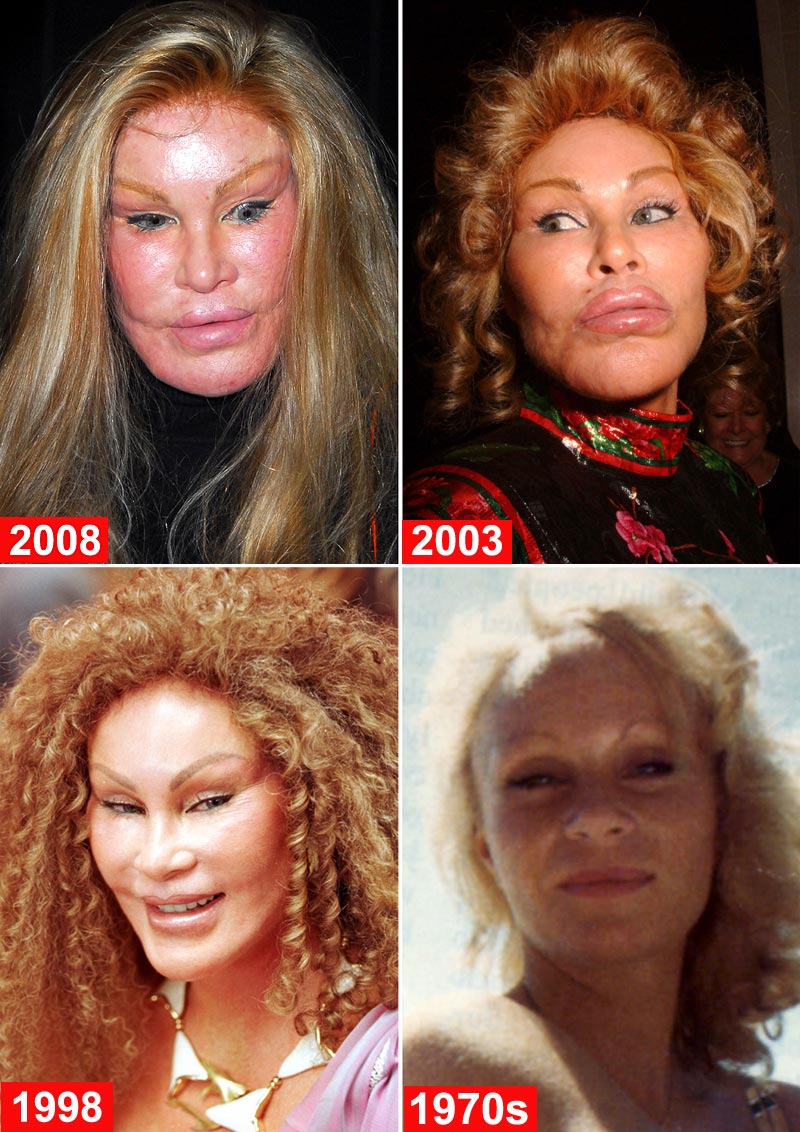 There's a touch of homage to Frankenstein here, a story system/body that embraces many tellings and modifications: visual, still, moving, sonic, tactile —many costume options (such as the options in the above image from fancy dress ideas), masks of various materials, skin paint, etc. meant to be temporary —though more permanent cosmetic surgery options exist, including peculiar assisted vanity operations (as shown in the image to the right of Jocelyn Wildenstein from The Daily Mail). Highly manipulated evolutions with intense visual impact without necessarily having direct genetic intervention to influence species change through natural or assisted breeding. Planned and unplanned, coerced or natural genetic mutation helps to produce that which, in departure from expectation and norms, seems monstrous, at least until advantages of the mutation become apparent. A possible monstrous outcome is a necessary risk if more ideal forms (from this tine of perception and that tine of perception) of mutation are to be attained. Various circumstances conspire (it might seem) or somehow align in order to support (temporarily) what emerges from the interaction system. That this happens can be extraordinary, mechanisms that resist maintenance of status quo, that resist, even if it seems pleasant and/or near perfect, permanence, that participate in change —by any means that are or become (tines that emerge, for instance, as consequences or outcomes of interactions) possible.
There's a touch of homage to Frankenstein here, a story system/body that embraces many tellings and modifications: visual, still, moving, sonic, tactile —many costume options (such as the options in the above image from fancy dress ideas), masks of various materials, skin paint, etc. meant to be temporary —though more permanent cosmetic surgery options exist, including peculiar assisted vanity operations (as shown in the image to the right of Jocelyn Wildenstein from The Daily Mail). Highly manipulated evolutions with intense visual impact without necessarily having direct genetic intervention to influence species change through natural or assisted breeding. Planned and unplanned, coerced or natural genetic mutation helps to produce that which, in departure from expectation and norms, seems monstrous, at least until advantages of the mutation become apparent. A possible monstrous outcome is a necessary risk if more ideal forms (from this tine of perception and that tine of perception) of mutation are to be attained. Various circumstances conspire (it might seem) or somehow align in order to support (temporarily) what emerges from the interaction system. That this happens can be extraordinary, mechanisms that resist maintenance of status quo, that resist, even if it seems pleasant and/or near perfect, permanence, that participate in change —by any means that are or become (tines that emerge, for instance, as consequences or outcomes of interactions) possible. That transformation is possible is celebrated in many instances of human-manipulated morphing. A redirection of a natural (without direct intervention) progression of form via deliberate structural manipulation whose outcomes may match or deviate (immediately or over time) from a target. Efforts to shape an inevitable change in appearance. Efforts to control inevitable change. To set inevitable tines of change in motion. To stop a tine of events from progressing along what may seem an inevitable path system to inevitable destinations. Of course, intentions and outcomes are systems that may converge and diverge along paths that themselves are systems of gestures and behaviors, shaping and being shaped by interactions with systems of variables on some scale in some location[s] for some duration[s] of time. ¡O for the love of variables!
James Whale's (a filmmaker who who once was a cobbler) 1931 cinematic achievement: Watch Dr. Frankenstein as the moment of achievement emerges in a temporarily ultimate configuration cobbled together from various parts, assembled from diverse sources yet IT'S ALIVE!
All of existence in involved at all times in telling the complex, compelling (I think), story systems of a shared existence system; all of existence is involved in this telling (an assembled involvement in this moment) even without consent or awareness of telling the story, which is to say that telling the story everything is telling
The moving architecture of existing, of meaning; the assembled story body that itself moves, dances, explores space, that actively tells a story can be explored in work by Theo Jansen, a kinetic sculptor (the Theo Jansen link is to a story system tine about the strandbeest moving in the video story tine of a strandbeest/Jansen collaboration system):
What follows is an assembled story system, a form of video collage story body system that, as described on the video story body's youtube page, is:
- footages of Heima Dvd
- footages of Theo Jansen docs
- footages of differents Sigur Ros clips
for the great song of Sigur ros
Labels:
BMW Z4,
body,
change,
cobble,
configuration,
evolution,
expression of joy,
frankenstein,
interaction,
limited fork,
perception,
plastic surgery,
storytelling,
system,
theo jansen,
transformation
Monday, October 11, 2010
Call for STOP AND READ...
This is a very interesting essay I found about meaningless work and the "Boxes of Meaningless work" from Walter de Maria... SEEMS meaningless, but its TOTALLY WORTH to read....
MEANINGLESS WORK
Meaningless work is obviously the most important and significant art form today. The aesthetic feeling given by meaningless work can not be described exactly because it varies with each individual doing the work. Meaningless work is honest. Meaningless work will be enjoyed and hated by intellectuals - though they should understand it. Meaningless work can not be sold in art galleries or win prizes in museums - though old fasion records of meaningless work (most all paintings) do partake in these indignities. Like ordinary work, meaningless work can make you sweat if you do it long enough. By meaningless work I simply mean work which does not make money or accomplish a conventional purpose. For instance putting wooden blocks from one box to another, then putting them back to the original box, back and forth, back and forth etc., is a fine example of meaningless work. Or digging a hole, then covering it is another example. Filing letters in a filing cabinet could be considered meaningless work, only if one were not considered a secretary, and if one scattered the file on the floor periodically so that one didn't get any feeling of accomplishment. Digging in the garden is not meaningless work. Weight lifting, though monotonous, is not meaningless work in its aesthetic since because it will give you muscles and you know it. Caution should be taken that the work chosen should not be too pleasurable, lest pleasure becomes the purpose of the work. Hence, sex, though rhythmix, can not stictly be called meaningless - though I'm sure many people consider it so.
Meaningless work is potentially the most abstract, concrete, individual, foolish, indeterminate, exactly determined, varied, important art-action-experience one can undertake today. This concept is not a joke. Try some meaningless work in the privacy of your own room. In fact, to be fully understood, meaningless work should be done alone or else it becomes entertainment for others and the reaction or lack of reaction of the art lover to the meaningless work can not honestly be felt.
Meaningless work can contan all of the best qualities of old art forms such as painting, writing, etc. It can make you feel and think about yourself, the outside world, morality, reality, unconsciousness, nature, history, time, philosophy, nothing at all, politics, etc. without the limitations of the old art forms.
Meaningless work is individual in nature and it can be done in any form and over any span of time - from one second up to the limits of exhaustion. It can be done fast or slow or both. Rhythmically or not. It can be done anywhere in any weather conditions. Clothing, if any, is left to the individual. Whether the meaningless work, as an art form, is meaningless, in the ordinary sense of that term, is of course up to the individual. Meaningless work is the new way to tell who is square.
Grunt
Get to work
March, 1960.
Walter De Maria, american artist and composer.
MEANINGLESS WORK
Meaningless work is obviously the most important and significant art form today. The aesthetic feeling given by meaningless work can not be described exactly because it varies with each individual doing the work. Meaningless work is honest. Meaningless work will be enjoyed and hated by intellectuals - though they should understand it. Meaningless work can not be sold in art galleries or win prizes in museums - though old fasion records of meaningless work (most all paintings) do partake in these indignities. Like ordinary work, meaningless work can make you sweat if you do it long enough. By meaningless work I simply mean work which does not make money or accomplish a conventional purpose. For instance putting wooden blocks from one box to another, then putting them back to the original box, back and forth, back and forth etc., is a fine example of meaningless work. Or digging a hole, then covering it is another example. Filing letters in a filing cabinet could be considered meaningless work, only if one were not considered a secretary, and if one scattered the file on the floor periodically so that one didn't get any feeling of accomplishment. Digging in the garden is not meaningless work. Weight lifting, though monotonous, is not meaningless work in its aesthetic since because it will give you muscles and you know it. Caution should be taken that the work chosen should not be too pleasurable, lest pleasure becomes the purpose of the work. Hence, sex, though rhythmix, can not stictly be called meaningless - though I'm sure many people consider it so.
Meaningless work is potentially the most abstract, concrete, individual, foolish, indeterminate, exactly determined, varied, important art-action-experience one can undertake today. This concept is not a joke. Try some meaningless work in the privacy of your own room. In fact, to be fully understood, meaningless work should be done alone or else it becomes entertainment for others and the reaction or lack of reaction of the art lover to the meaningless work can not honestly be felt.
Meaningless work can contan all of the best qualities of old art forms such as painting, writing, etc. It can make you feel and think about yourself, the outside world, morality, reality, unconsciousness, nature, history, time, philosophy, nothing at all, politics, etc. without the limitations of the old art forms.
Meaningless work is individual in nature and it can be done in any form and over any span of time - from one second up to the limits of exhaustion. It can be done fast or slow or both. Rhythmically or not. It can be done anywhere in any weather conditions. Clothing, if any, is left to the individual. Whether the meaningless work, as an art form, is meaningless, in the ordinary sense of that term, is of course up to the individual. Meaningless work is the new way to tell who is square.
Grunt
Get to work
March, 1960.
Walter De Maria, american artist and composer.
Monday, October 4, 2010
Nice Failures
With a malfunctioning program the following images came out simply by varying one variable:
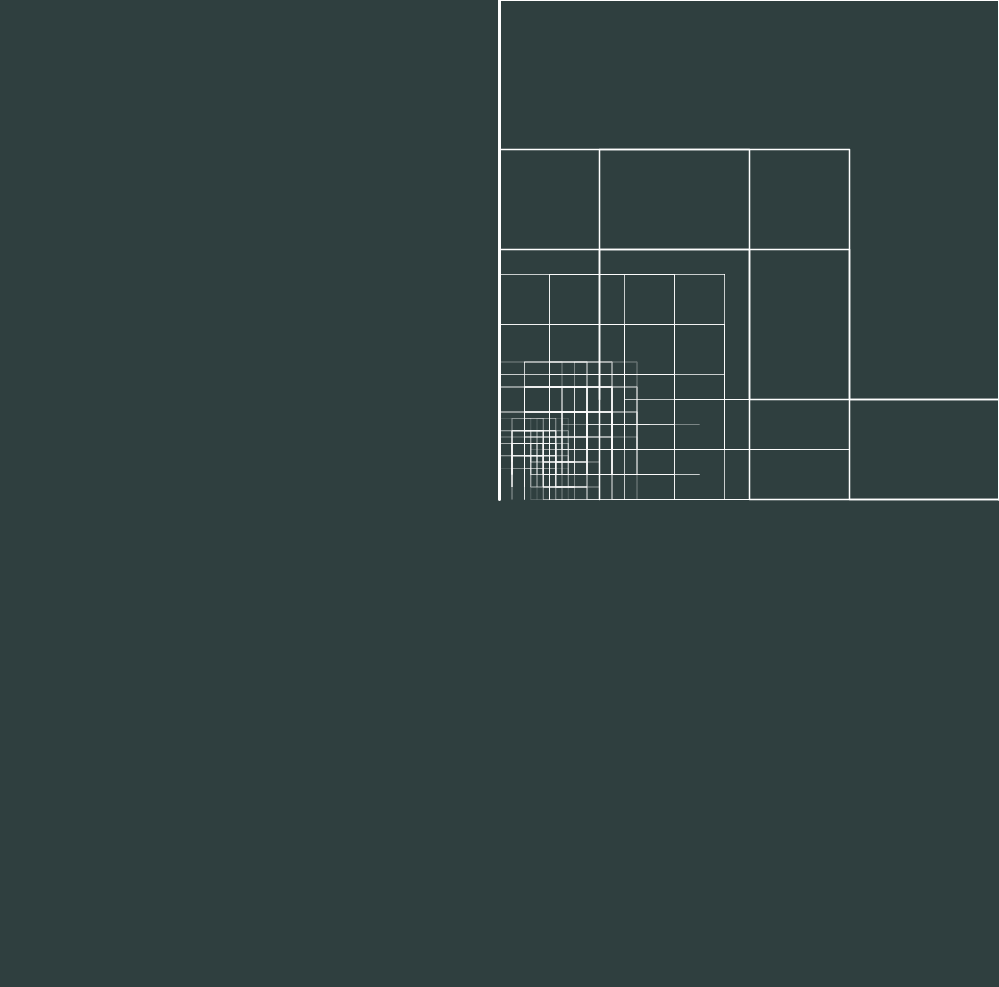
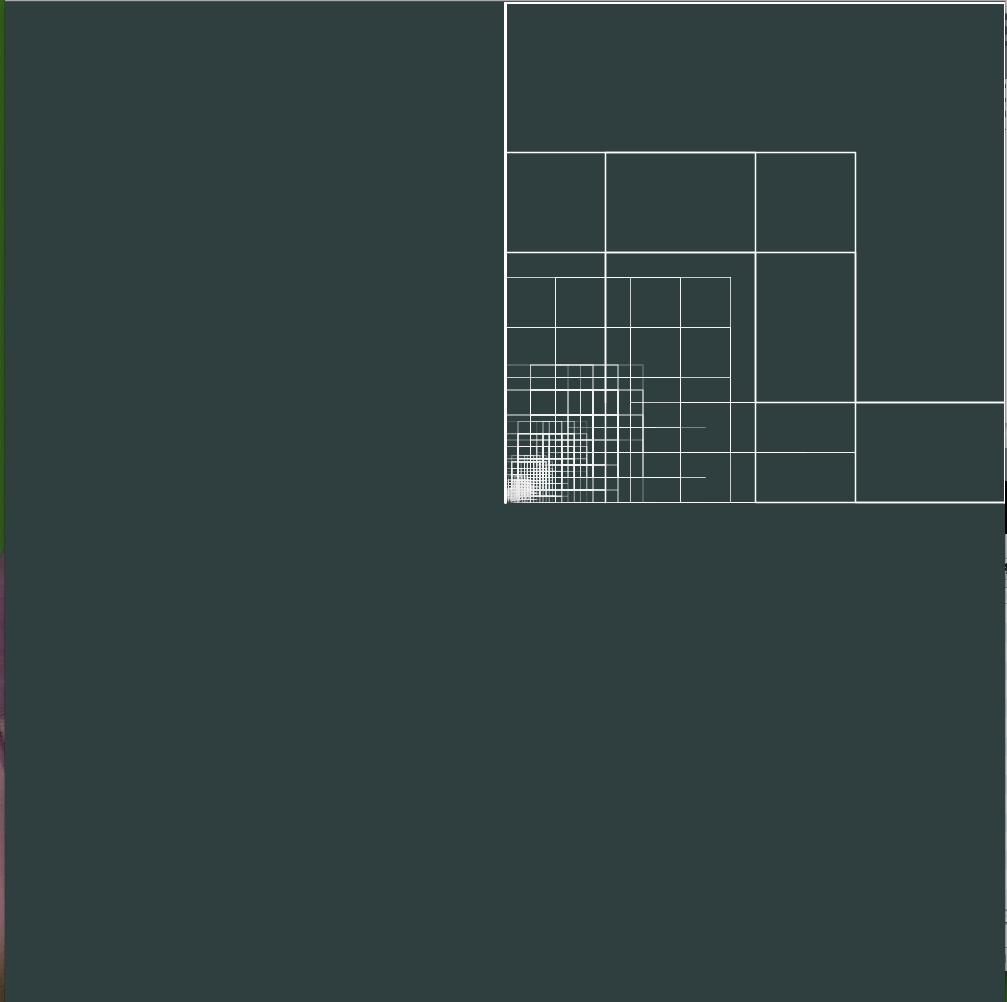
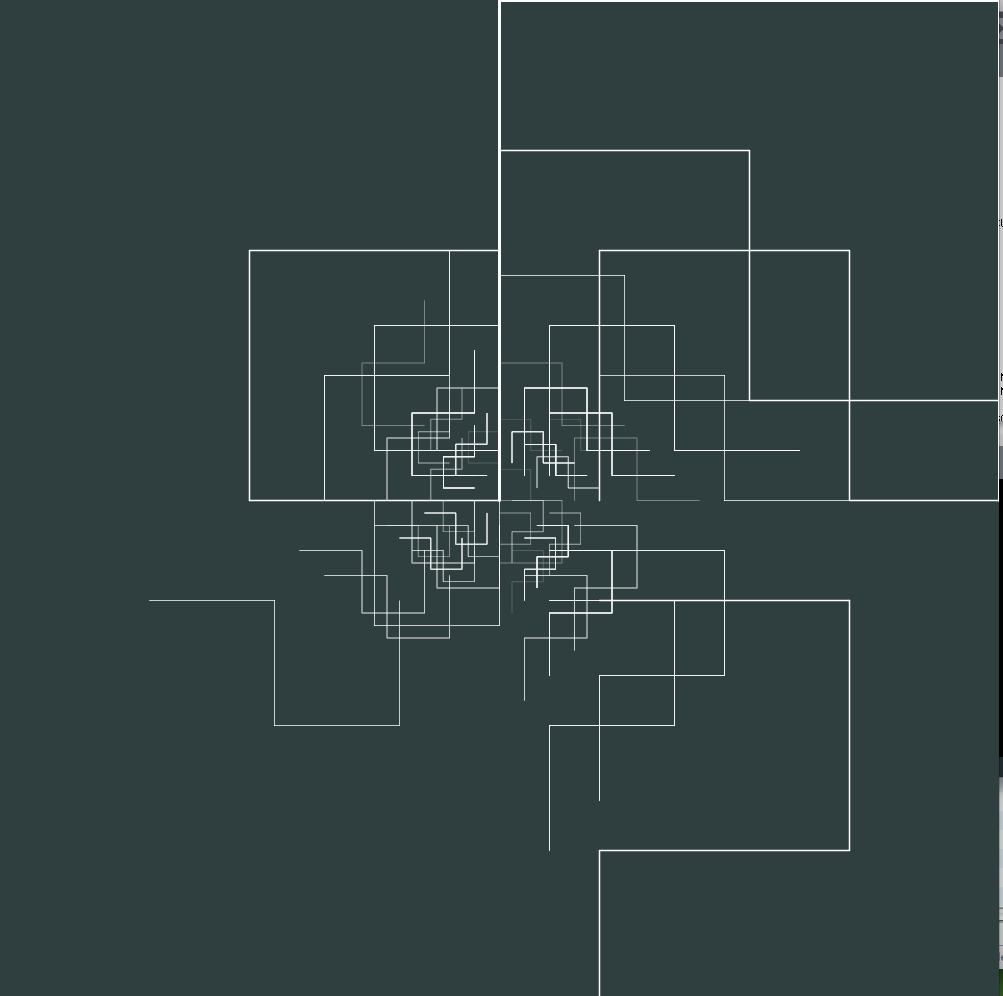
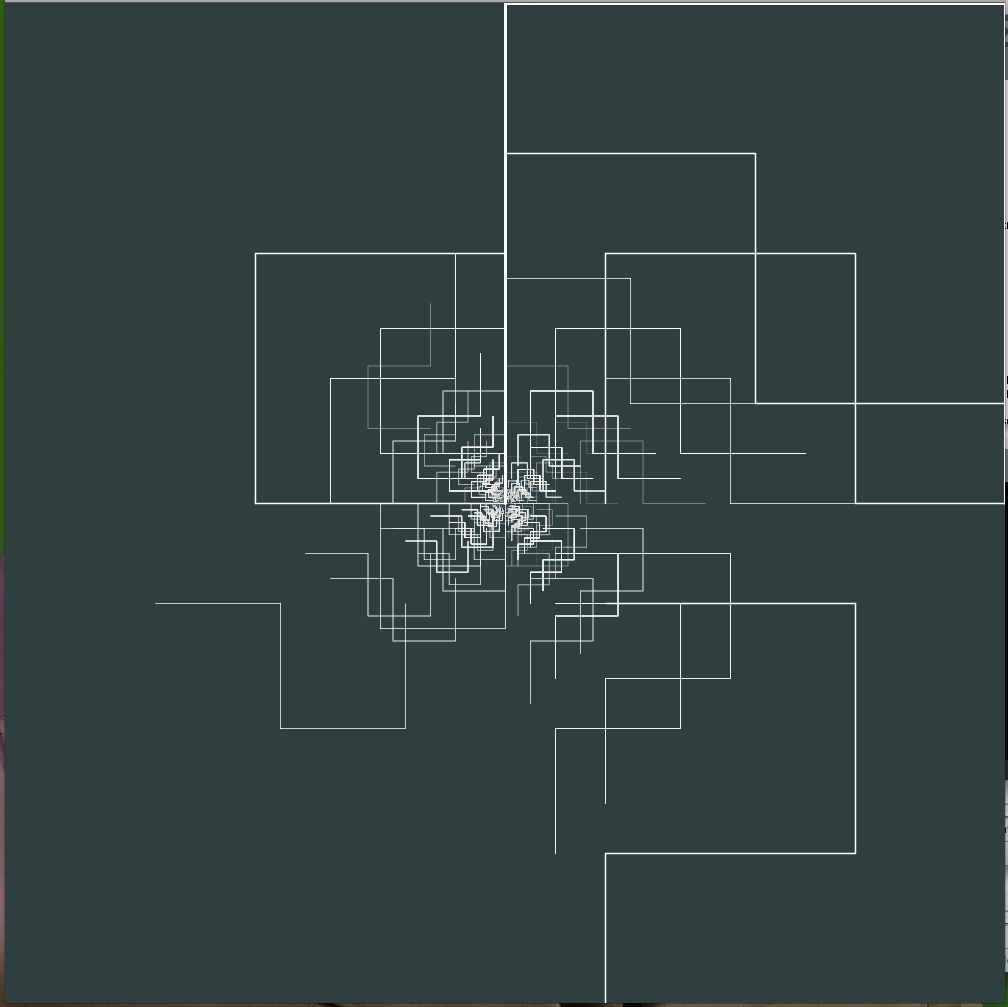
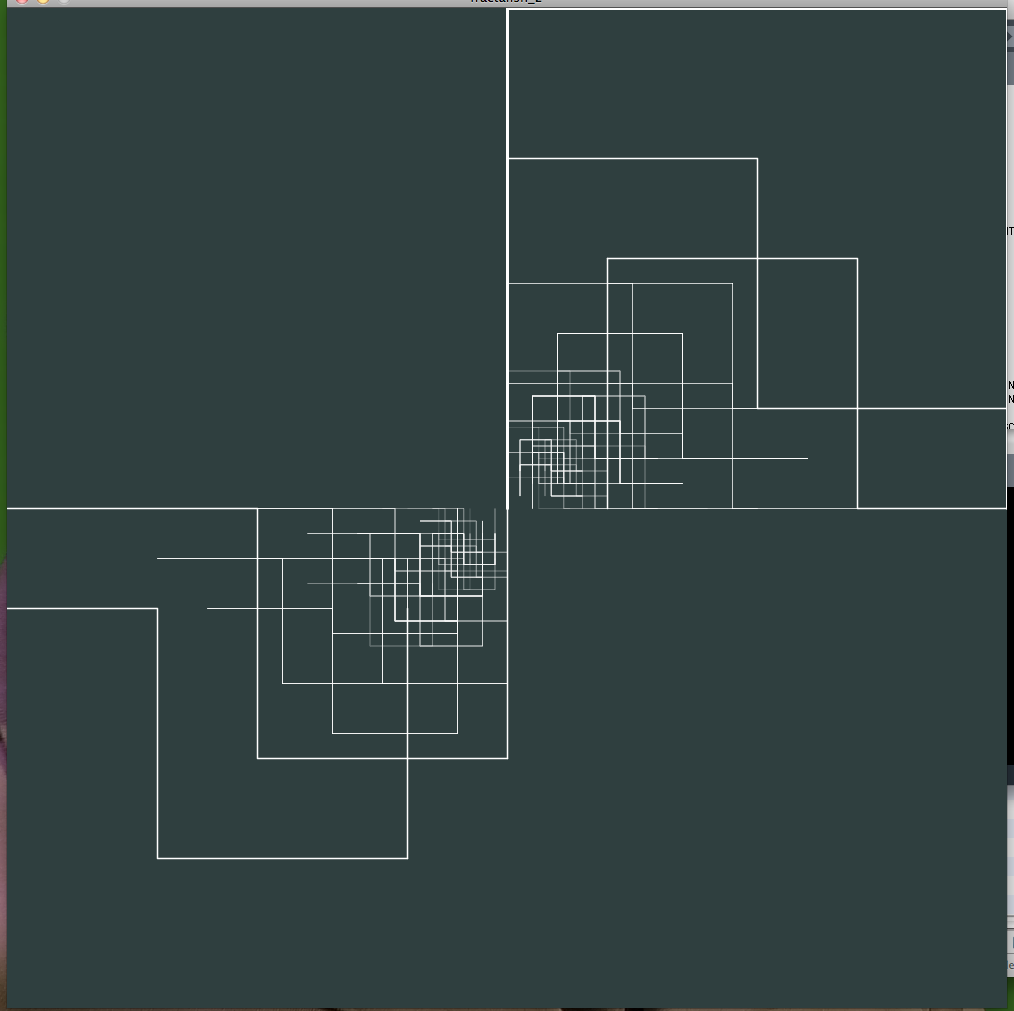
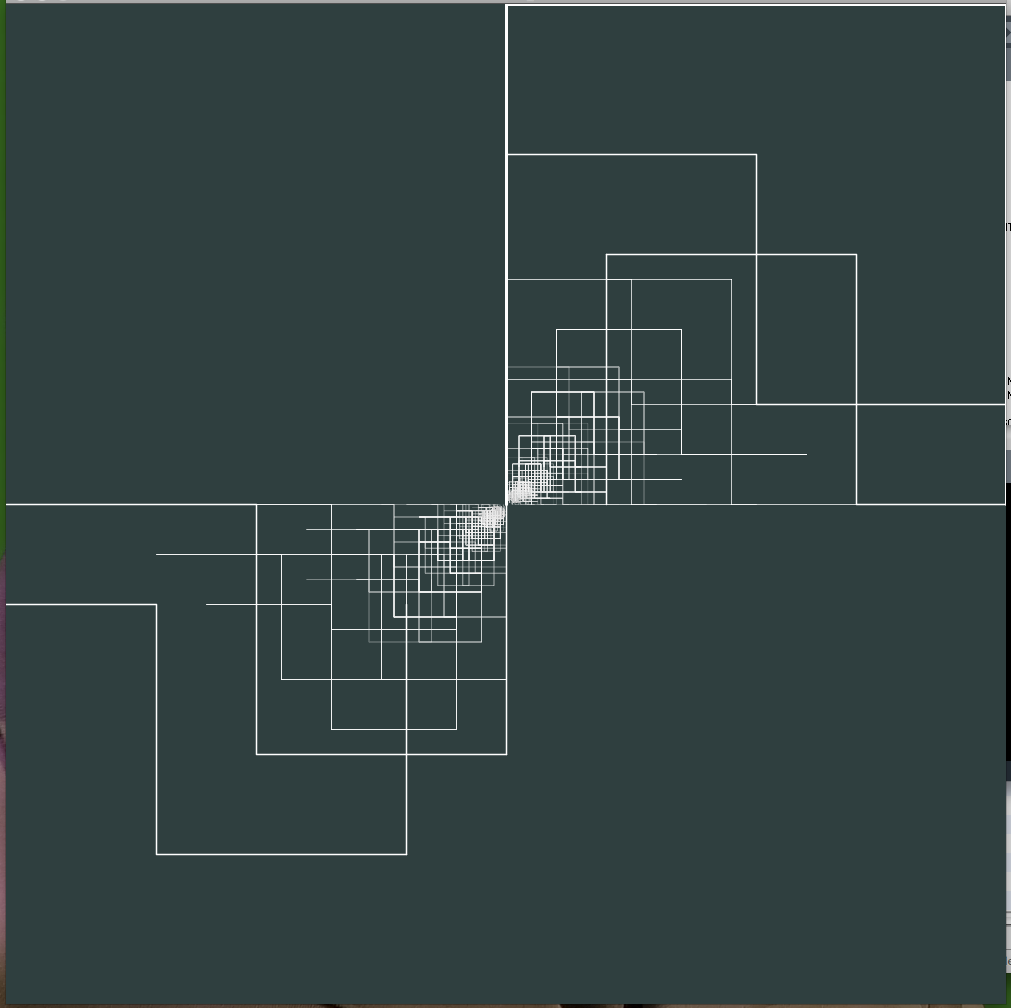
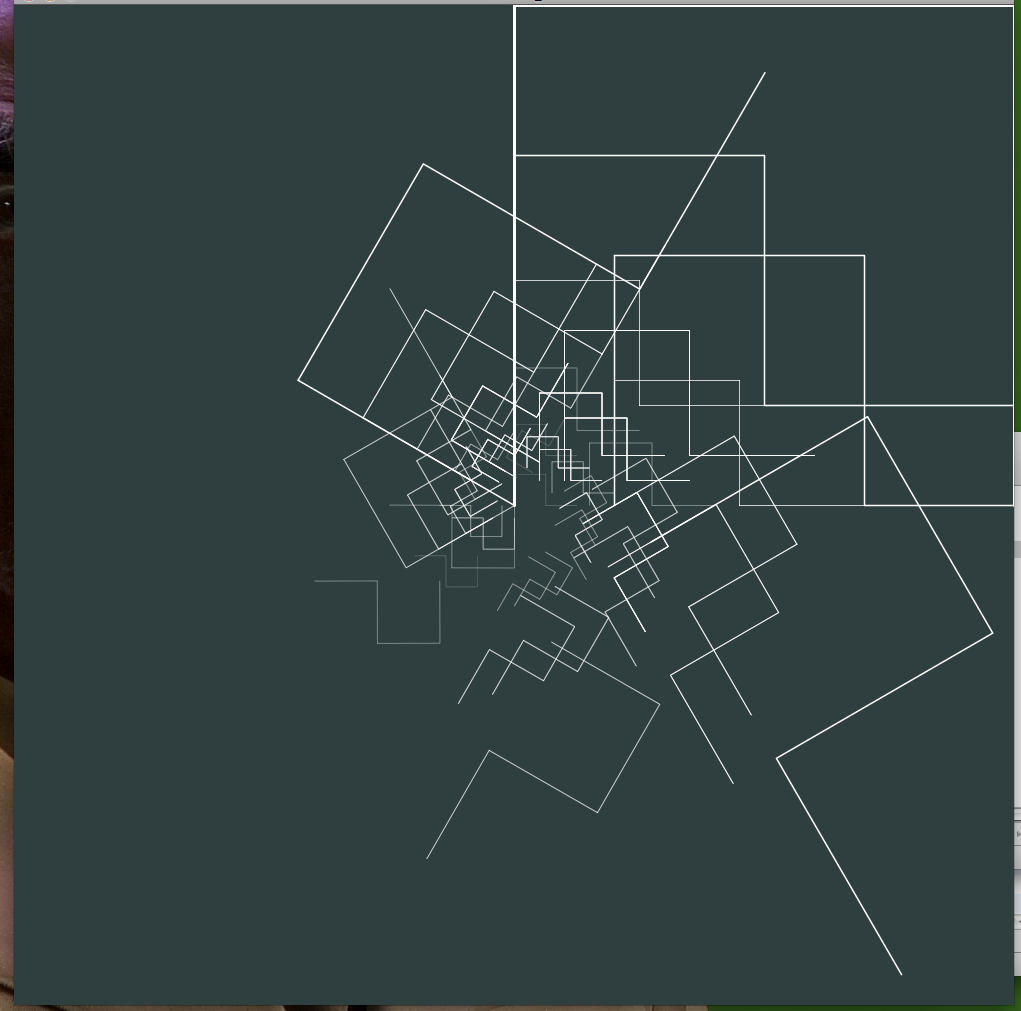
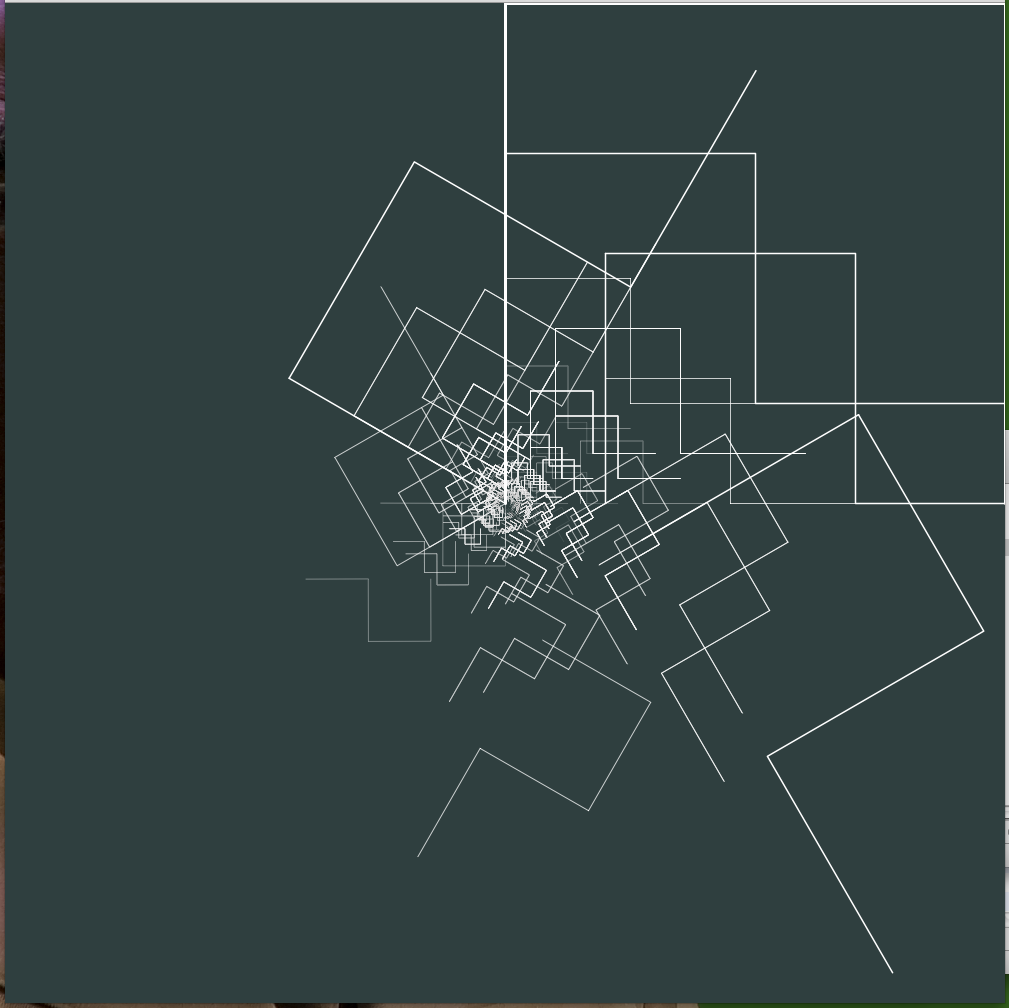








Sunday, October 3, 2010
Subscribe to:
Posts (Atom)




